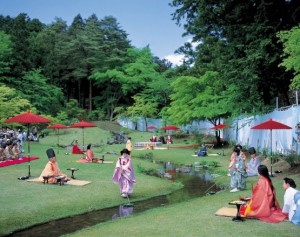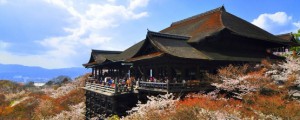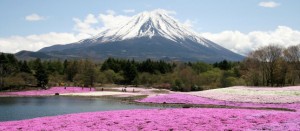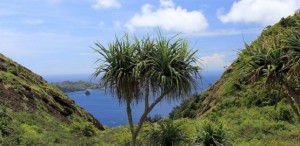World Heritage of UNESCO in Japan
The elements of cultural heritage
- Gusuku castle and the related monuments of Ryukyu Kingdom

This castle was listed in 2000 and it is located in Okineva prefecture. During several centuries Ryukyu Kingdom was cultural and economic centre among the south-western Asian countries, Korea, China and Japan. Everything is clearly reflected in maintained monuments. Ryukyu Kingdom culture was originated and thrived in special political and economic conditions. The history of Ryukyu Kingdom reaches to 500 years, from the 12th up to the 17th centuries. Everything began from the 10th and the 12th centuries when the local farming communities (“Gusuku”) began to fence their lands with stonewalls. However, in 1879 Ryukyu Kingdom ceased to exist when this territory officially became Okinawa region.
2.Horyu-ji Buddhist monuments
These monuments were listed in 1993 and located in Nara prefecture.
There are nearly 48 Buddhist monuments in Horyu-ji area. Some of them where built at the end of the 7th century and at the beginning of the 8th century. Accordingly, these monuments are considered to be the ancient wooden maintained monuments all over the world. These wooden masterpieces are very important both for art and religion history. Moreover, the construction of these masterpieces was parallel with the Buddhism introducing from China.
3.Himeji-jo castle
The castle was listed in 1993 and located in Hyogo prefecture.
Himeji-jo castle is a properly maintained masterpiece in architecture. It was built at the beginning of the 17th century. The castle consists of 83 parts. It is protected with protective system and with unique equipments in the beginning of shogun era. This wooden construction of architectural art reflects also functionalism and aesthetics. The castle is a vivid symbol of feudalism. It was overwhelming in Japan to the Meiji restoration to 1868.
A number of castles were constructed in Japan during Shogun era. A lot of them were destroyed and some of them were ruined during wartime. Only some of them were maintained, however, Himeji-jo castle is very different in its maintenance comparing with other maintained castles.
4. Hiraizumi – temples, gardens and other archeological constructions of the Buddhist Pure Land
The construction was listed in 2011 and located in Iwate prefecture.
It has 5 constructions, including Kinkeisan Saint Mountain. Currently Hiraizumi is connected with Kyoto. However, in early times it was administrative centre of the northern parts of Japan. The government building comes from the 11th and the 12th centuries and it is partially maintained. The area was a castle of the Buddhism Pure Earth. In this area The Buddhism Pure Earth created wonderful conceptions of design and gardening for Japan.
5. Hiroshima Peace Memorial (Genbaku Dome)
This memorial was listed in 1996.
Due to the talented people only (Genbaku Dome) was remained undestroyed during atomic bombings of Hiroshima on August 6, 1945. This is not only grim memory on the most destructive power of the world created by human being ever. It is also a symbol of hope that peace will be all over the world and there will be refusing of atomic weapon.
6. Historical monuments of ancient Kyoto (Kyoto, Uji and Otsu cities)
The monument was listed in 1994 and located in Otsu, in Kyoto and Shiga prefectures.

It was constructed in 794 typical to the Chinese ancient capital. During the mid-19th century at the beginning of its foundation Kyoto was the capital of Japan. During thousands of years Kyoto was a Japanese cultural centre. Kyoto reflects Japanese wooden architecture mainly in religious constructions. Here Japanese gardening art was developed having great influence on world gardening art.
7. Historical monuments of ancient Nara
The monument was listed in 1998 and located in Nara prefecture.
From 710 to 784 Nara was the capital of Japan. During this period the united system of national governing was created. Accordingly, Nara being Japanese cultural centre was thriving. The historical monuments of the city-Buddhist temples, Shinto saint places and the ruins of emperor kingdom appeared during excavations. All these told about Japanese capital life in the 8th century. That period was full of important political and cultural changes.
8.Historical villages of Shirakawa-go and Gokayama
The villages were listed in 1995 and located in Gifu and Toyama prefectures.
These villages are located in a mountainous area and for a long time they have been separated from the outside world. Residents of gassho style houses survived by growing mulberry and silkworm. This is the only place in Japan, where big houses with huge straw roofs were built. Despite economic changes, village Ogimati, Aynokura and Suganuma are excellent examples of traditional way of life. They ideally adapted to the environment and socio-economic conditions of people’s lives.
9. ItsukushimaShintoShrine
The shrine was listed in 1996 and located in Hiroshima prefecture.
In the lower part of Seto sea Itsukushima Island is considered to be saint Shinto place. It is supposed that the first construction of the temple was even in the 6th century. This saint place was built in the 12th century in harmonic form and shows artistic taste and the talent of the constructors. This saint place reflects the diversity of forms and colors. It describes Japanese landscape ideas connecting together the nature and the human being creativity.
10.Iwami Ginzan Silver Mine and Cultural Monuments
This mine was listed in 2007 and located in Ota city, Shimane prefecture.
Iwami Ginzan Silver Mine is situated in the south-western part of Honshu Island. It is a huge mountain range surrounded with deep valleys. These valleys still reflect the trails of those mines which were existed from the 16th up to the 20th centuries.
Here transportation roads of silver mine were also preserved. These transportation roads led to the port cities where ore was sent to China and Korea. Mines made a significant contribution to overall economic development of Japan and the south-eastern Asia in the 16th and the 17th centuries promoting the mass production of gold and silver in Japan. Currently this territory is covered with trees. Here there is also a fort, shrine and partly Kaido transportation roads leading to the coast and the port cities Tomogaura, Okidomari and Yunotsu. In these three cities ore was loaded on ships.
11.Sacred Places and Pilgrimage Routes in the Kii Mountain Range
These places were listed in 2004 and located in territory of Mie, Nara and Wakayama prefectures.
Kii Mountains are surrounded with dense forests and there are 3 saint places here: Yoshino and Omine, Kumano Sanzan and Koyasan. The pilgrimage routes connect the two ancient capital cities of Nara and Kyoto. There we see wonderful mixture of Shinto, coming from the ancient Japanese tradition of nature warship, and Buddhism which came to Japan from China and Korean Peninsula. This region is unique with its rivers and waterfalls and has approximately 15 million visitors annually. Each of these three places has a temple. Some of them were founded even in the 9th century.
12.Shrines and Temples of Nikko
The place was listed in 1999 and located in Tochigi prefecture.
During several centuries shrines and temples of Nikko together with nature were saint places. They are famous architectural and decoration masterpieces. This place is closely connected with Tokugawa Shogun history.
13.Fuji Mountain, sacred place and source of creative inspiration
The mountain was listed in 2013 and located in Honshu Island.

A lot of pilgrims and painters have come to Fuji Mountain from early times. Engravings of the 19th century with Fuji Mountain images glorified this mountain all over the world. Accordingly, the mountain became one of the famous symbols of Japan. This place includes also 25 places reflecting the sacred essence and the inspired image of Fuji Mountain.
14. Tomioka silk mill and related sites
The mill was listed in 2014 and located in Gumma prefecture.
The mill was founded in 1872 in order to produce and export high quality silk. The mill had an important role in silk production and in this domain it was a link between France and Japan. The mill consists of four sites: each of them elaborates the silk raw material in different stages of production.
Mill of Natural heritage
15.OgasawaraIslands
The islands were listed in 2011.

Ogasawara archipelago or the so-called Bonn Islands connect together nearly 30 islands. They are about 1000 km south from Tokyo. The island consists of 30 other islands. They are divided into 3 groups and cover 7939 hectares area. The islands are famous with their landscape diversity and rich fauna. There are 195 species of endangered birds and a rare type of flying mice the so-called Bonin Flying Fox. There are many corals and sharks in the waters of this area.
16. Shirakami-Sanchi Mountains
The mountains were listed in 1999 and located in the north of Honshu Island in Aomori and Akita prefectures.
There are mountains in the south of Honshu Island which are full of the last Siebold beeches. There were times when these beeches made bushes and covered the all hills and mountains of the northern regions of Japan. In these forests you can see black bear and 87 species of birds.
17.Shiretoko
Shiretoko Peninsula was listed in 2005 and located in the north-eastern part of Hokkaido Island.
Shiretoko Peninsula is located in the north-eastern part of the most northern Japanese Island Hokkaido. The peninsula includes its central part to the Shiretoko headland and the surrounding marine area. It is an excellent example of interaction of marine and terrestrial ecosystem. Shiretoko has an important significance for marine and terrestrial species. Some of them are endangered or endemic. This area is much more important for seabirds and migratory birds and for marine mammals, including sea lion and some cetacean species.
Yakushima Island was listed in 1993 and located in Kagoshima prefecture.
The center of Yakushima Island is covered with rich flora. There are about 1900 plant species and subspecies. In Yakushima ancient forests of endangered zone are preserved which are typical for this area.
the material is taken from http://visitjapan.ru/japan/unesco/
translated from Armenian into English by Tatev Harutyunyan













